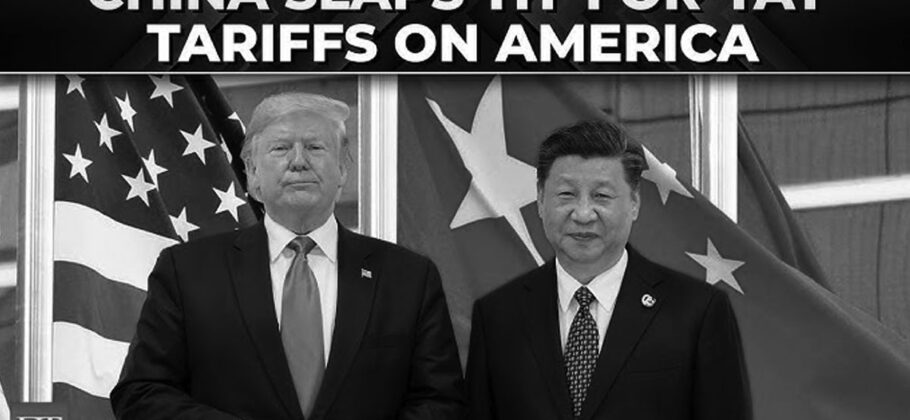The economic tug-of-war between the United States and China has reached a new flashpoint. In response to the latest round of U.S. tariffs, China has announced retaliatory duties set to take effect on Monday, February 10. These tariffs, worth an estimated $14 billion in American exports, come in direct response to President Donald Trump’s 10% tariff hike on all Chinese goods. With tensions escalating, experts are warning of the potential for a prolonged trade war with severe global economic consequences.
Beijing’s latest measures impose a 15% border tax on U.S. coal and liquefied natural gas, along with a 10% tariff on crude oil, agricultural machinery, and large-engine vehicles. The impact is expected to be felt most in the U.S. energy and manufacturing sectors, particularly in states that heavily rely on these industries. In addition to these tariffs, China has tightened its export controls on 25 rare metals, many of which are essential for electronic devices and military equipment. These restrictions could have long-term ramifications for global supply chains, particularly in high-tech industries.
China’s swift countermeasures are in direct response to Trump’s latest tariff policy, which aims to pressure Beijing into addressing U.S. concerns over fentanyl exports. However, Chinese officials have dismissed this justification, accusing the U.S. of using the fentanyl issue as a pretext for broader economic aggression. The move is also seen as an attempt by Beijing to show strength in the face of escalating trade tensions, signaling to Washington that it will not back down easily.
Political and Economic Implications
Trump’s tariff strategy appears to be part of a broader plan to reshape U.S. trade relationships and address what he sees as unfair foreign competition. However, the rapid imposition of tariffs—without sufficient time for negotiations—may have backfired. Some analysts suggest that the short window Trump gave for talks was intended to force quick concessions from China, but instead, it only hardened Beijing’s stance.
China’s response also extends beyond tariffs. In a move that appears politically motivated, Beijing has launched an anti-monopoly investigation into Google and has added American fashion giant PVH (owner of Calvin Klein and Tommy Hilfiger) to its “unreliable entity” list. These actions indicate that China is willing to use multiple economic levers to counter U.S. pressure.
Who Will Be Affected—and Who Might Benefit?
Reactions to the unfolding trade conflict have been mixed. Some economic analysts warn that the tit-for-tat tariffs could spiral into a full-blown trade war, with damaging effects on both economies. Zhang Yanshen, an expert at the China Center for International Economic Exchanges, has cautioned that this may be “just the beginning of this phase of the trade war.” Meanwhile, Wendy Cutler, a trade expert at the Asia Society Policy Institute, suggests that Beijing may wait to see how the tariffs impact China’s economy before deciding on further action.
While certain U.S. industries, particularly in energy and agriculture, will take an immediate hit, other sectors and international players could see significant gains in the short term. Investors and businesses may look to capitalize on the following areas over the next few months:
- U.S. Domestic Energy Producers (Non-Coal): With China imposing tariffs on U.S. coal and LNG, alternative energy producers, particularly those targeting Europe and Latin America, could benefit.
- Alternative Agricultural Exporters (Latin America, Australia, Canada): As China shifts away from U.S. agricultural imports, markets in Brazil, Argentina, and Australia stand to gain from increased trade.
- Rare Earth Mining and Processing (Outside China): With China restricting exports of key metals, rare earth mining operations in the U.S. (MP Materials), Canada, and Australia could become more lucrative.
- U.S. Domestic Auto Manufacturers (Non-Large Engine Vehicles): While large-engine vehicles face new tariffs, smaller and mid-sized auto manufacturers catering to the domestic market may thrive.
- Chinese Tech and E-Commerce Companies: With increased scrutiny on U.S. tech firms, Chinese companies like Alibaba, Baidu, and Huawei could expand their market share.
- Logistics and Shipping Companies (Non-China Routes): Firms facilitating trade in Southeast Asia, Mexico, and India may see an uptick as supply chains shift away from China.
- Mexico and Southeast Asia-Based Manufacturers: Companies moving operations to Vietnam, Thailand, and India as an alternative to China could benefit significantly.
Despite the rising tensions, Trump has signaled that more tariffs could be on the way if China does not make concessions. However, he has also suggested that a deal remains possible, particularly if Beijing is willing to address U.S. concerns over issues beyond trade, such as China’s relationship with Russia and its stance on the war in Ukraine.
FAM Editor: As always, this is not investment advice, do your own damned research. But this will likely not be over for a couple of months at least, so watch for opportunities.











